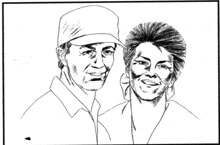Dennis and Jeanie Fagerland
 For 20 years, the Fagerlands have been farming on top of the Prairie Coteau, a geological formation left by the last glacier 10,000 years ago. It is an area of profuse wetlands and tallgrass prairie. The production from their farm includes livestock, wheat, corn, and an abundance of wildlife. The Fagerlands have been excellent land stewards. They have restored more than 30 drained wetlands, resulting in at least 120 surface acres of water. The wetlands are the center-piece for the farm and provide habitat for shorebirds, waterfowl, and dozens of other species within the wildlife community. More than-800 acres of cropland also have been planted to perennial grasses and legumes to protect the watersheds of the wetlands. These practices are reducing the sediment and nutrients going into the farm’s 100-acre natural lake.
For 20 years, the Fagerlands have been farming on top of the Prairie Coteau, a geological formation left by the last glacier 10,000 years ago. It is an area of profuse wetlands and tallgrass prairie. The production from their farm includes livestock, wheat, corn, and an abundance of wildlife. The Fagerlands have been excellent land stewards. They have restored more than 30 drained wetlands, resulting in at least 120 surface acres of water. The wetlands are the center-piece for the farm and provide habitat for shorebirds, waterfowl, and dozens of other species within the wildlife community. More than-800 acres of cropland also have been planted to perennial grasses and legumes to protect the watersheds of the wetlands. These practices are reducing the sediment and nutrients going into the farm’s 100-acre natural lake.
The Fagerlands also use other conservation practices. They have used reduced-tillage farming practices, rotational grazing systems, and controlled burning on their grasslands, and they have planted multi-species tree belts to add to the biodiversity of the landscape. Nesting structures for giant Canada geese and wood duck nesting boxes also are common on the farm. The Fagerlands have sought to strike a balance between their farming and wildlife goals, and their farm is a showplace for both environmental and agricultural interests. Dennis was a presenter at the 1993 Wetlands Forum in Pierre, South Dakota, and the farm was a part of the Natural Resources Conservation Service’s Midwest Wetlands Tour in November 1994. Ducks Unlimited, the U.S. Fish and Wildlife Service, the Natural Resources Conservation Service, and the local soil conservation district have helped with conservation efforts on the farm.
— Paul M. Bultsma, Ducks Unlimited